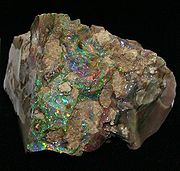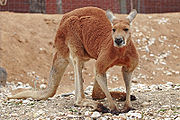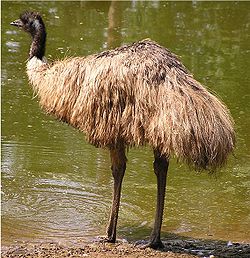
National symbols of Australia
Encyclopedia

Australia
Australia , officially the Commonwealth of Australia, is a country in the Southern Hemisphere comprising the mainland of the Australian continent, the island of Tasmania, and numerous smaller islands in the Indian and Pacific Oceans. It is the world's sixth-largest country by total area...
to represent what is unique about the nation, reflecting different aspects of its cultural life and history.
Official symbols
| Symbol | Image | Adopted | Remarks | |
|---|---|---|---|---|
| Flag Flag A flag is a piece of fabric with a distinctive design that is usually rectangular and used as a symbol, as a signaling device, or decoration. The term flag is also used to refer to the graphic design employed by a flag, or to its depiction in another medium.The first flags were used to assist... |
Flag of Australia Flag of Australia The flag of Australia is a defaced Blue Ensign: a blue field with the Union Flag in the canton , and a large white seven-pointed star known as the Commonwealth Star in the lower hoist quarter... |
 |
3 September 1901 | The flag includes the southern cross, Union Jack and Commonwealth Star Commonwealth Star The Commonwealth Star is a seven-pointed star symbolising the Federation of Australia which came into force on 1 January 1901.... . |
| National anthem National anthem A national anthem is a generally patriotic musical composition that evokes and eulogizes the history, traditions and struggles of its people, recognized either by a nation's government as the official national song, or by convention through use by the people.- History :Anthems rose to prominence... |
Advance Australia Fair Advance Australia Fair "Advance Australia Fair" is the official national anthem of Australia. Created by the Scottish-born composer, Peter Dodds McCormick, the song was first performed in 1878, but did not gain its status as the official anthem until 1984. Until then, the song was sung in Australia as a patriotic song... |
19 April 1984 | ||
| National colours National colours National colours are frequently part of a country's set of national symbols.Many states and nations have formally adopted a set of colours as their official "national colours" while others have de facto national colours that have become well-known through popular use... |
Green and gold Green and gold The national colours of Australia are green and gold, as proclaimed by Sir Ninian Stephen, the Governor-General of Australia on 19 April 1984... |
19 April 1984 | Green and gold are also the traditional team colours of Australian national sporting teams. | |
| National Floral Emblem Floral emblem In a number of countries, plants have been chosen as symbols to represent specific geographic areas. Some countries have a country-wide floral emblem; others in addition have symbols representing subdivisions. Different processes have been used to adopt these symbols - some are conferred by... |
Golden Wattle Acacia pycnantha |
 |
19 August 1988 | It is a tree which flowers in late winter and spring |
| National Gemstone Gemstone A gemstone or gem is a piece of mineral, which, in cut and polished form, is used to make jewelry or other adornments... |
Opal Opal Opal is an amorphous form of silica related to quartz, a mineraloid form, not a mineral. 3% to 21% of the total weight is water, but the content is usually between 6% to 10%. It is deposited at a relatively low temperature and may occur in the fissures of almost any kind of rock, being most... |
 |
27 July 1993 | Opal production was worth $71.4 million to Australia in 2003 and supports many communities in New South Wales, South Australia and Queensland. |
| Coat of arms Coat of arms A coat of arms is a unique heraldic design on a shield or escutcheon or on a surcoat or tabard used to cover and protect armour and to identify the wearer. Thus the term is often stated as "coat-armour", because it was anciently displayed on the front of a coat of cloth... |
Coat of arms of Australia Coat of arms of Australia The coat of arms of Australia is the official symbol of Australia. The initial coat of arms was granted by King Edward VII on 7 May 1908, and the current version was granted by King George V on 19 September 1912, although the 1908 version continued to be used in some contexts, notably appearing on... |
 |
19 September 1912 | Originally granted by King George V George V of the United Kingdom George V was King of the United Kingdom and the British Dominions, and Emperor of India, from 6 May 1910 through the First World War until his death in 1936.... |
Unofficial Emblems
| Symbol | Image | Remarks | |
|---|---|---|---|
| National animals | Red Kangaroo Red Kangaroo The Red Kangaroo is the largest of all kangaroos, the largest mammal native to Australia, and the largest surviving marsupial. It is found across mainland Australia, avoiding only the more fertile areas in the south, the east coast, and the northern rainforests.-Description:This species is a very... Macropus rufus |
 |
Unofficial national mammal emblems |
| National bird | Emu Emu The Emu Dromaius novaehollandiae) is the largest bird native to Australia and the only extant member of the genus Dromaius. It is the second-largest extant bird in the world by height, after its ratite relative, the ostrich. There are three subspecies of Emus in Australia... Dromaius novaehollandiae |
 |
Unofficial national Bird emblems |
| National personification National personification A national personification is an anthropomorphization of a nation or its people; it can appear in both editorial cartoons and propaganda.Some early personifications in the Western world tended to be national manifestations of the majestic wisdom and war goddess Minerva/Athena, and often took the... |
Boxing Kangaroo Boxing Kangaroo The boxing kangaroo is a national symbol of Australia, frequently seen in popular culture. The symbol is often displayed prominently by Australian spectators at sporting events, such as at cricket, tennis and football matches, and at the Commonwealth and Olympic Games. The flag is also highly... |
Unofficial national personifications | |
Australian Icons
Icons of Australian culture are almost as well known by Australians and visitors as unofficial symbols.| Image | Remarks | |
|---|---|---|
| Sydney Opera House Sydney Opera House The Sydney Opera House is a multi-venue performing arts centre in the Australian city of Sydney. It was conceived and largely built by Danish architect Jørn Utzon, finally opening in 1973 after a long gestation starting with his competition-winning design in 1957... |
 |
Open since 1973, it has come to represent ' Australia'. |
| Uluru Uluru Uluru , also known as Ayers Rock, is a large sandstone rock formation in the southern part of the Northern Territory, central Australia. It lies south west of the nearest large town, Alice Springs; by road. Kata Tjuta and Uluru are the two major features of the Uluṟu-Kata Tjuṯa National Park.... |
.jpg) |
Uluru is one of Australia’s most recognisable natural icons |
| Akubra Hat Akubra Akubra is an Australian brand of bush hat, whose wide-brimmed styles are a distinctive part of Australian culture, especially in rural areas. The name is believed to be derived from an Aboriginal word for head covering.... |
 |
A popular Australian brand of hat. |
| Vegemite Vegemite Vegemite is a dark brown Australian food paste made from yeast extract. It is a spread for sandwiches, toast, crumpets and cracker biscuits, and filling for pastries... |
 |
A well-known Australian food spread. |

